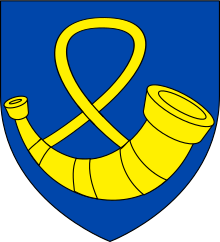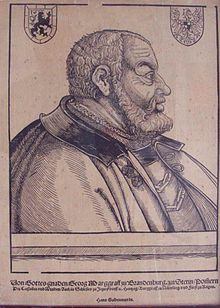Duchy of Jägerndorf
The Duchy of Jägerndorf (Czech Krnovské knížectví ) was created in 1377 through the division of the Přemyslid Duchy of Opava , which was a fiefdom of the Crown of Bohemia and whose area belonged to the Margraviate of Moravia until 1318 . The place of residence was the town of Jägerndorf (today Krnov in the Okres Bruntál in the Czech Republic).
history
After the death of Duke Nicholas II in 1365, who came from the Troppau branch of the Bohemian Přemyslids , the Duchy of Opava was transferred to his sons John I , Nicholas III. , Wenceslaus I. and Přemysl / Primislaus I. divided. The eldest of the brothers, John I, received the Duchy of Ratibor as the sole heir , making him the progenitor of the Premyslid line of Troppau-Ratibor. After another division of the Duchy of Opava in 1377, Johann I also received Jägerndorf , which was elevated to a duchy, as well as the Freudenthal area . After Johann I's death Ratibor and Jägerndorf came to his older son Johann II "the Iron" . He sold Jägerndorf in 1384 to Wladislaus II of Opole , from whom Margrave Jobst of Moravia acquired it in 1390 , who kept it until his death in 1411. In 1422 Johann II received the Duchy of Jägerndorf back, which had last been in the hands of Ludwig II of Liegnitz , as a gift from Emperor Sigismund . After Johann II's death in 1424, his possessions came to his sons Wenzel von Ratibor († 1456) and Nicholas V († 1452), who did not share the inherited territories until 1437. Nikolaus V received Jägerndorf, Freudenthal, Pless , Rybnik , Loslau and Sohrau , while Wenzel became Duke of Ratibor. After the death of Duke Nicholas V in 1452, Jägerndorf and Loslau passed to his son Johann IV. Ä. († 1483), who was a supporter of King George of Podebrady . Johann IV's brother Wenzel († 1479) received Rybnik with Sohrau and Pleß.
During the Hungarian-Bohemian war for supremacy in Bohemia, Johann IV. Jägerndorf lost in 1474 to the Bohemian opposing king Matthias Corvinus , who is said to have stolen it from him in a cruel way. Matthias Corvinus entrusted the administration of the duchy to his Upper Silesian governor, Johann Bjelik von Kornitz . After the death of the rightful owner, Duke Johann IV. D. Ä. In 1483, his sister Barbara († 1510), who was married to Johann IV of Auschwitz , obtained a promise from Matthias Corvinus that Jägerndorf would be returned after his death. Presumably it actually came to the reign of Jägerndorf in 1490, but a short time later the Bohemian King Vladislav Jägerndorf gave it to his chancellor Johann von Schellenberg as a fief. An agreement with Duchess Barbara was brought about by the fact that Barbara's daughter Helene was married to Georg von Schellenberg, the son of Johann von Schellenberg. This also gave him the position of a Silesian prince.
Property of the Hohenzollern
In 1523 Georg von Schellenberg sold Jägerndorf to Margrave Georg the Pious because of financial difficulties . With Georg, the House of Hohenzollern sought to gain influence in the Silesian duchies. For this reason Georg, who was financially strong through the inheritance of his wife Beatrice de Frangepan , the widow of Johann Corvinus , pursued a corresponding acquisition policy and the marriage policy of the Hohenzollern was also geared towards this goal. Georg built Schloss Jägerndorf under the direction of Hans Beheim . He is considered an early and active promoter of the Reformation and was in direct contact with Martin Luther . Despite the largely peaceful adoption of the new faith, he drove out the Teutonic Order , the Franciscans (OFM) and the Minorites based in Jägerndorf . Under his son Georg Friedrich as his successor, a conflict developed out of the Bohemian land law on the one hand, which favored the estates in the disputed points and was held in the Bohemian language, and on the other hand Roman law , which favored the margrave as territorial lord and was held in German . Still, Georg Friedrich's policies were financially sound and peaceful, including religious ones. After Georg Friedrich died childless, the transition from Jägerndorf to Elector Joachim Friedrich became a point of contention with the emperors, who represented the interests of the House of Habsburg and tried to reduce the influence of the Hohenzollerns in Silesia. With the son of Elector Johann Georg , the rule of the Hohenzollern in Jägerndorf also ended. His hostile policy towards Ferdinand II because of the threatened loss of his claims culminated in his energetic support for Frederick V of the Palatinate during the uprising in Bohemia . As a result of the defeat in the Battle of the White Mountain , Johann Georg was given eight and lost his possessions.
Property of the Princes of Liechtenstein

Since Johann Georg was not ready to convert to Catholicism, he had to flee to Hungary after the battle of the White Mountain . His Bohemian possessions were confiscated by Emperor Ferdinand II in 1621 . On March 15, 1623, the Emperor, in his capacity as King of Bohemia, transferred the Duchy of Jägerndorf to his loyal supporter Karl I of Liechtenstein , who had owned the Duchy of Opava since 1613 . He united the two duchies to form the Duchy of Troppau-Jägerndorf and rigorously re-catholized the subjects. His descendants remained in possession of their Bohemian lands until they were expropriated in 1945.
In the field of tension between Prussia and Austria
Already in 1592 it was established with an expert opinion of the Breslau bishop Andreas von Jerin , who also held the office of the Silesian chief captain, that the purchase of Jägerndorf was made by inheritance law and that it had been confirmed, however, that alienation by the Hohenzollern had to be prevented. Finally, in 1608, Emperor Rudolf II rejected the Hohenzollern claims as unfounded. This fact led to the so-called Jägerndorfer question , with which the later Prussian royal house justified its claim to Jägerndorf and which ultimately led to the outbreak of the First Silesian War in 1740 . As a result of this war, most of Silesia fell to Prussia in 1742 after the preliminary peace of Breslau and the subsequent peace of Berlin . The northern part of the Duchy of Jägerndorf was incorporated into the Duchy of Opole in what is now Prussian Silesia. The southern part of the duchy and the city of Jägerndorf itself remained with Bohemia and were added to the newly created Austrian Silesia .
Belonging to Austrian Silesia (Kronland since 1850) 1750–1918
By the following administrative reforms, the Duchy Jägerndorf belonged since 1751 to the political County Jägerndorfer circle (Czech Krnovský kraj ) that in 1783 the Opava district (Czech Opavský kraj ) was incorporated. In the years 1848–1849 the Duchy of Jägerndorf belonged to Silesia (1 district). As a result of the reforms after the March Revolution , the duchy was dissolved in 1849 and the political district Jägerndorf (Czech politický okres Krnov ) was established on its territory in 1850 , which existed until Czechoslovakia was founded in 1918. The until then Moravian enclave of the Hotzenplotzer Ländchen (Czech Osoblažsko ) also belonged to it.
Modern times
This part came to the newly founded Czechoslovakia in 1918. As a result of the Munich Agreement in 1938, the area became part of the Reichsgau Sudetenland and thus the German Reich. It belonged to the Troppau administrative district and formed the Jägerndorf district . After the end of World War II, the area reverted to Czechoslovakia in 1945 . The part that had remained in Silesia since 1742 fell to Poland in 1945.
Dukes of Jägerndorf
See also: List of the Dukes of Silesia
- 1377–1378 Johann I , † 1380/82, son of Nicholas II of Troppau
- 1378–1384 Johann II. († 1424), son of Johann I.
- 1384–1390 Ladislaus II of Opole
- 1390–1411 Margrave Jobst of Moravia
- 1411–1422 Ludwig II of Liegnitz
- 1422–1424 Johann II (received back in 1422 Jägerndorf as a gift from Emperor Sigismund )
- 1424–1452 Nikolaus V († 1452), son of John II (1424–1437 together with his brother Wenzel († 1456))
- 1452–1474 Johann IV († 1483), 1464–1474 together with his brother Wenceslaus († 1479), sons of Nicholas V, lost the duchy in the armed conflicts between Hungary and Bohemia
- 1474–1490 against king Matthias Corvinus († 1490)
- 1490–1493 Barbara, daughter Nikolaus V, married to Johann IV. Von Teschen-Auschwitz († 1495/97)
- 1493–1506 Johann von Schellenberg, Chancellor of the Bohemian King Vladislav ( as a fief )
- 1506–1523 Georg von Schellenberg, Prince of Jägerndorf, sold in 1523 to Hohenzollern
- 1523–1543 Georg von Brandenburg-Ansbach "the Pious" († 1543)
- 1543–1603 Georg Friedrich von Brandenburg-Ansbach († 1603), son of Georg
- 1603–1606 Joachim Friedrich of Brandenburg († 1608)
- 1606–1621 Johann Georg von Brandenburg († 1624), his Bohemian possessions were confiscated by the emperor after the battle of the White Mountain
- Duchy of Troppau-Jägerndorf:
- From March 15, 1623 until the duchy was extinguished in 1849: Charles I of Liechtenstein and after him the respective Prince of Liechtenstein .
literature
- in order of appearance
- Faustin Ens : The Oppaland, or the Troppauer Kreis, according to its historical, natural history, civil and local characteristics . Volume 4: Description of the location of the principalities of Jägerndorf and Neisse, Austrian Antheils and the Moravian enclaves in the Troppauer district , Vienna 1837 ( E-Copy ).
- Karl August Müller: Patriotic images, or history and description of all castles and knight palaces in Silesia and the county of Glatz. Second edition, Glogau 1844, pp. 178-181.
- Gottlieb Biermann : History of the Duchies of Troppau and Jägerndorf . Prochaska, Teschen 1874 ( e-copy ).
- Joachim Bahlcke , Winfried Eberhard, Miloslav Polívka (eds.): Handbook of historical places . Volume: Bohemia and Moravia (= Kröner's pocket edition . Volume 329). Kröner, Stuttgart 1998, ISBN 3-520-32901-8 , pp. 222-224.
- Ludwig Petry et al. (Hrsg.): Geschichte Schlesiens . Tape. 1: From prehistoric times to 1526 . 5th revised edition. Thorbecke, Sigmaringen 1988, ISBN 3-7995-6341-5 . Pp. 184f, 239, 289.
- Ludwig Petry et al. (Hrsg.): Geschichte Schlesiens . Tape. 2: The Habsburg period 1526–1740 . Thorbecke, Sigmaringen 1988. ISBN 3-7995-6342-3 .


